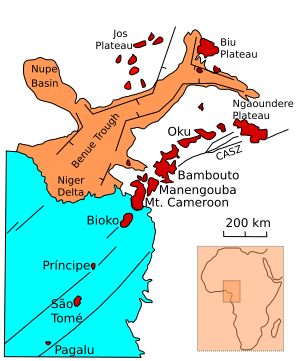Four-horned chameleon facts for kids
Quick facts for kids Four-horned chameleon |
|
|---|---|
 |
|
| A four-horned chameleon from Mount Kupe in Cameroon | |
| Conservation status | |
| Scientific classification | |
| Genus: |
Trioceros
|
| Species: |
quadricornis
|
 |
|
| A map illustrating highland areas of the Cameroon line, including some of those inhabited by the four-horned chameleon | |
| Synonyms | |
|
|
The four-horned chameleon (Trioceros quadricornis) is a special kind of chameleon. It's a lizard that belongs to the family called Chamaeleonidae. You can find this amazing creature in the high mountains of western Cameroon and southeastern Nigeria. It's known for the cool horns on its head!
Contents
Discovering the Four-Horned Chameleon
The four-horned chameleon was first officially described in 1899. A German scientist named Gustav Tornier was the one who gave it its scientific name.
Different Types of Four-Horned Chameleons
Scientists have found three different types, or subspecies, of the four-horned chameleon. Think of them like different versions of the same animal. Each one has a slightly different scientific name:
- T. q. quadricornis (Tornier, 1899) – This is the original southern four-horned chameleon.
- T. q. eisentrauti (Mertens, 1968) – This one is named after a German zoologist, Martin Eisentraut.
- T. q. gracilior (Böhme & Klaver, 1981) – This is the northern four-horned chameleon.
When you see a name in parentheses after a subspecies, it means that type was first described under a different main group (genus) of animals.
Where the Four-Horned Chameleon Lives
The four-horned chameleon lives only in certain high mountain areas. These areas are part of the Cameroon line in Cameroon and eastern Nigeria. You can find them in places like the Bamenda Highlands, Bamboutos massif, Mount Manengouba, and Mount Kupe.
Its Special Home
One subspecies, T. q. eisentrauti, is special because it lives only in the Rumpi Hills of Cameroon. This means it's endemic to that area, found nowhere else in the world!
These chameleons prefer to live in healthy mountain forests. They like places where there isn't much human activity. They usually live at heights between 1,150 and 2,400 meters (about 3,770 to 7,870 feet) above sea level. Scientists think they stay at these heights because of other chameleon species, not because they can't handle other temperatures.
What the Four-Horned Chameleon Looks Like and Does
Like many other chameleons, the four-horned chameleon has a tail that can grip things. It also has special claws on its toes to help it climb.
Horns and Size
Most of the time, this chameleon has four clear horns on its head. Sometimes it might have two big horns and a few smaller ones. Adult chameleons usually grow to be about 10 to 14 inches (25 to 36 centimeters) long, including their tail.
Male chameleons have a noticeable bulge near their tail and a "beard" under their chin. Some female chameleons can also have one or two horns on their snout.
What They Eat
The four-horned chameleon mostly eats arthropods. This means they munch on insects and other small creatures like spiders.
Protecting the Four-Horned Chameleon
The four-horned chameleon is considered a Vulnerable species. This means it's at risk of disappearing. The International Union for Conservation of Nature (IUCN) gave it this status.
Threats to Their Home
There are several reasons why these chameleons are in trouble. People cutting down trees for wood (logging) and clearing land for farms (agricultural expansion) are big problems. This destroys the forests where the chameleons live.
Pet Trade Concerns
Even though the four-horned chameleon is a protected animal in Cameroon, some people still catch them to sell as pets. This "pet trade" has caused the number of chameleons to drop a lot in some areas. Protecting their homes and stopping illegal trade are important steps to help them survive.



